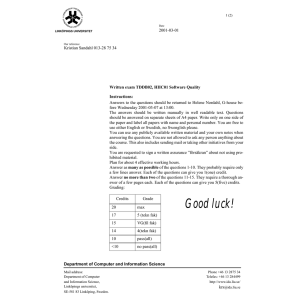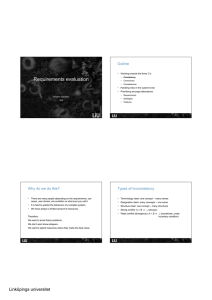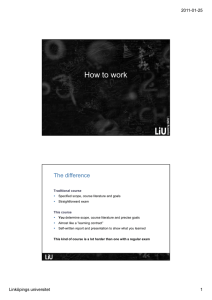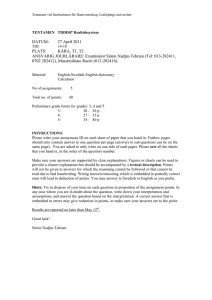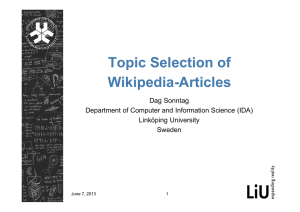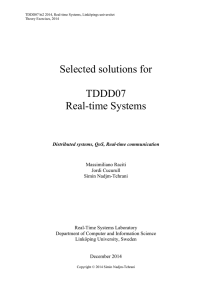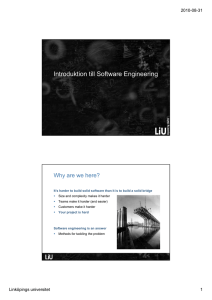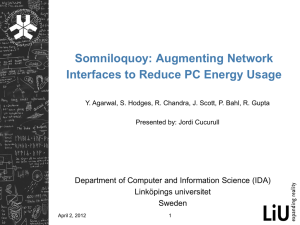Lecture 4 - Process & Entry Strategies 2013
advertisement
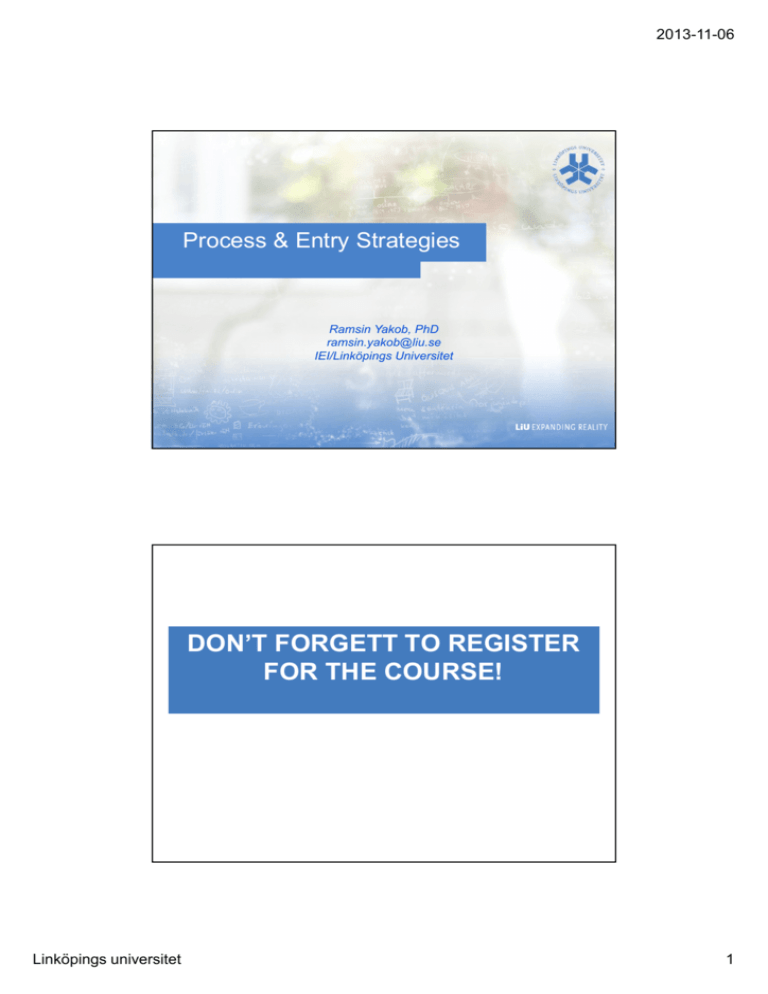
2013-11-06 Process & Entry Strategies Ramsin Yakob, PhD ramsin.yakob@liu.se IEI/Linköpings Universitet DON’T FORGETT TO REGISTER FOR THE COURSE! Linköpings universitet 1 2013-11-06 Internationalization as process • The Internationalization Process involve the extension of economic activities across national boundaries. A quantitative and qualitative process which leads to a more extensive geographical pattern of economic activity… • Challenge: Liability of Foreignness - The costs of doing business abroad that result in a competitive disadvantage for an MNE subunit • Arises predominantly from the unfamiliarity of the environment • What are these disadvantages (costs)? 3 Challenge: Liability of Foreignness All additional costs a firm operating in a market overseas incur that a local firm would not incur. 1. Geographic or Spatial Distance 2. Cultural Distance 3. Administrative or Institutional Distance 4. Economic Distance Linköpings universitet 2 2013-11-06 The Strategic Challenge Challenges associated with engaging in FDI means that a number of questions has to be asked by the TNC! LIABILITY OF FOREIGNESS INTERNATIONALIZATION Economic Extension, Cross-border, Qualitative/ Quantitative, •Unfamiliarity •Spatial Distance •Firms Specific costs •Host/Home country •environment FDI • Ownership • Control Internationalization ”questions” Why? What? When? Where? How? Linköpings universitet 3 2013-11-06 Theoretical Paradigms Trade theories • Transaction Theories • Comparative Advantage • Foreign Direct Investment • Economics of Trade Internationalization of the firm – Strategic Perspectives • Eclectic Paradigm • Life-Cycle Theories • Internationalization Process • Multinational/Global Management • Competitive Advantage Basic Entry Decisions & Contrasting Paradigms WHY? External context (e.g. Porter): - environment, competitors, competitive advantage WHAT? HOW? Process view (e.g. Mintzberg): Management: process of change actions, interactions Internationalization Strategy WHERE? Economic Geography (e.g. Dicken): Location specific advantages and disadvantages, location endowment Linköpings universitet Resource-based approach (e.g. Hamel & Prahalad): firm specific resources, forward looking, pools of competencies WHEN? First-mover advantages (e.g. Lieberman & Montgomery): Pioneering advantages and costs 4 2013-11-06 What are our motives (the Why?) Market? Production volume? Innovation/product related? Resources? Costs? Risk? Foreign Authorities? Personal knowledge? Success (domestic)? Competition? Etc… 9 What to use for market entry • Firm advantages can be attributed to the control over bundles of unique material, human, organizational and location resources and skills that enable unique valuecreating strategies. • To be a source of sustained above-average performance, resources must be: (1)Valuable, meaning buyers are willing to purchase the resources' outputs at prices significantly above their costs (2)Rare, so that buyers cannot turn to competitors with the same or substitute resources (3)Imperfectly imitable, meaning it is difficult for competitors to either imitate or purchase the resources Linköpings universitet 5 2013-11-06 When to Enter • Mechanisms that confer advantages and disadvantages on firstmover firms. First-mover advantages in terms of the ability of pioneering firms to earn positive economic profits. • Advantages associated with entering early are “first-mover advantages” ” • - Ability to preempt rivals, establishing a strong brand name quickly - Ability to build sales volume - Ability of early entrants to create switching costs Disadvantages are “first-mover disadvantages” ” - Pioneering costs: costs only an early entrant has to bear - Possibility that regulations may change Where to locate Factors and sub-factors that may influence international location decisions: • • • • • • Costs Labour characteristics Infrastructure Proximity to suppliers Proximity to markets/ customers Proximity to parent company’s facilities • Proximity to competition • • • • • • • • Legal and regulatory framework Economic factors Government and political Factors Social and cultural factors Characteristics of a specific Location Quality of life 12 Linköpings universitet 6 2013-11-06 Where to locate Summary of preferred or expected procedure in making international location decisions: 1. Make clear the purpose for the overall business at the beginning of the process 2. Investigate countries, regional factors, geographical considerations, location alternatives and conduct market analysis/ economic analysis and feasibility studies 3. Identify both international and local factors involved for each alternative location 4. Evaluate the alternatives against established criteria 5. Make a selection and implement. 13 Example of Value Chain Configuration • The German automaker BMW employs 70,000 factory personnel at 23 sites in 13 countries to manufacture its vehicles. • Workers at the Munich plant build the BMW 3 Series and supply engines and body components to other BMW factories abroad. • In the United States, BMW has a plant in South Carolina, which makes over 500 vehicles daily for the world market. • In NE China, BMW makes cars in a joint venture with Brilliance China Automotive Holdings Ltd. • In India, BMW has a manufacturing presence to serve the needs of the rapidly growing South Asia market. • BMW must configure sourcing at the best locations worldwide, in order to minimize costs (e.g., by producing in China), access skilled personnel (by producing in Germany), remain close to key markets (by producing in China, India and the United States). 14 Linköpings universitet From Cavusgil et al., 2007) 7 2013-11-06 Internationalization as a sequential process (the How?) 15 The Internationalization Process of Firms: (Johanson & Vahlne, 1977) Linköpings universitet 8 2013-11-06 The Internationalization Process of Firms (Johansson & Vahlne, 2009) 17 Four stages of Internationalization The establishment chain: Increasing degree of market knowledge and market commitment. Decreasing psychic distance 1. No regular export activities – export 2. Export via independent representatives (Agents) 3. Establishment of foreign sales subsidiary 4. Establishment of foreign manufacturing facilities and subsidiaries Linköpings universitet 9 2013-11-06 But be be aware!...alternative aware: Alternative explanation But explanation Born Global (Oviat & McDougall, 2005) • “An international new venture as a business organization that, from inception, seeks to derive significant competitive advantage from the use of resources and the sale of outputs in multiple countries” • A firm that is international from inception, or early on, “Frog leaping”. • Foreign direct investment (ownership) is not a requirement. • Changing International Environment • Dramatic increases in the speed, quality, and efficiency of international communication and transportation • Increasing homogenization of many markets in distant countries • International financing opportunities are increasingly available • Human capital is more internationally mobile Linköpings universitet 10 2013-11-06 Born Global (Oviat & McDougall, 2005) Based on four elements: 1. Internalization of some transactions (ownership is not a must) 2. Alternative governance structures (the network structure) 3. Foreign location advantage (private knowledge) 4. Unique Resources (protected through patents, copyrights, imperfect imitability, licensing, network governance) Types of International New Ventures 22 Linköpings universitet 11 2013-11-06 Types of International New Ventures TYPE OF INTERNATIONAL NEW VENTURES DEFINING CHARACTERISTICS (I,II) New International Market Makers • • • • • Moving goods, systems and knowledge of inbound and outbound logistics Alternative structures Direct investment kept at a minimum Discovery of imbalances of resources between countries (II) Geographically Focused Start-ups • • • • • Serves the needs of a particular region geographically restricted More activities coordinated Competitive advantage in coordination of multiple value chain activities (IV) Global Start-ups • • • • • Extensive coordination among multiple organizational activities Network alliances in multiple countries Complex inimitability Skills at both geographic and activity coordination 23 The Choice of Entry Mode? (the HOW) Indirect Exporting Direct Advantages and Disadvantages? Linköpings universitet 12 2013-11-06 Foreign Market Entry Forms • Three generic forms • Importance will differ due to industry and/or firm specific factors 1. Domestic production + Exports 2. International + Contract based agreement 3. International + Equity control Modes of Internationalization Linköpings universitet 13 2013-11-06 Choosing the Mode of Entry • Decision Criteria for Mode of Entry: - Market Size and Growth - Risk - Government Regulations - Competitive Environment/Cultural Distance - Local Infrastructure - Scale of entry 27 . Advantages & Disadvantages of Entry Modes ENTRY MODE ADVANTAGE DISADVANTAGE EXPORTING e.g. Trading companys, Mitsubishi Corp • Domestic representatives have market firm/product knowledge • Reliant on drive and character of local representatives • High level of market control • High transport costs • Ability to realize location and experience-curve economies • Problem with local marketing agents • Avoid establishment costs • Competition with low-cost location manufacturers SALES AGENTS • Allows increased market control e.g. Airline • Agents have good local knowledge sales rep., of host market • Agents have permanent presence in the market Linköpings universitet • Contractual complexity • Problems identifying good Agents • Agents may sell conflicting products • Agreements can be costly and difficult to terminate 14 2013-11-06 Advantages & Disadvantages of Entry Modes ENTRY MODE ADVANTAGE DISADVANTAGE LICENSING e.g. CocaCola, Disney • Licensee bares capital costs – low financial risk • Lack of control over technology • Low cost way to access market potential • Licensee provides knowledge of markets • Avoid tariffs, NTBs , quotas, and restrictions on foreign investment FRANCHISING • Low financial risk Body-Shop, • Low-cost way to access market KFC, potential McDonalds • Avoid tariffs, NTBs and restrictions on foreign investment • Maintain more control that with licensing • Inability to engage in global strategic coordination • Limited market opportunities/profits • Dependence on licensee • Possibility of creating future competitor • Limited market opportunities/profits • Dependence on franchisee • Potential conflicts with franchisee • Prohibited movements of profits • Quality controls • Franchise provides knowledge of local market Advantages & Disadvantages of Entry Modes ENTRY MODE ADVANTAGE DISADVANTAGE JOINT VENTURES e.g. SonyEricsson, FujitsoSiemens • Eased market entry • Incompability of partners • Shared expertise • Need to share knowledge and know-how WHOLLY OWNED SUBSIDIARY e.g. Airlines, Automotive, Manufact., Assembly Linköpings universitet • Synergy effects • Vested interests by both parties • Allows for sharing of risks • Conflicts in distribution of earnings – contractual complexity • Opportunity to learn about new market • Loss of autonomy • High profit potential • Maintain control over operations • High financial and managerial investments • Acquire knowledge of local market • Higher exposure to political risks • Avoid tariffs and NTBs • Vulnerability to restrictions on foreign investments • Protection of technology • Ability to engage in global strategic coordination • Requires strong coordination • Greater managerial complexity 15 2013-11-06 Advantages & Disadvantages of Entry Modes ENTRY MODE ADVANTAGE DISADVANTAGE TURNKEY CONTRACTS/ PROJECTS e.g. Automotive, Hospitals, Power-plants • Can earn a return on knowledge assets • Less risky than conventional FDI • No long-term interest in the foreign market • May create a competitor • Selling process tech • May be selling competitive advantage STRATEGIC ALLIANCES e.g. Starbucks & BarnesNoble, Hewlett Packard & Disney • Facilitate entry into market • Share fixed costs • Bring together skills and assets that neither company has or can develop • Establish industry technology standards • Competitors get low cost route to technology and markets • Giving up some authority/control • Loss of technological knowhow • Loss of management practices • Loss of operating procedures Scale of Entry Large scale entry - Strategic Commitments: decisions that have long-term impact and are difficult to reverse • Local distributors, partners will take you seriously - May cause rivals to rethink market entry - But may lead local firms to attack aggressively Small scale entry - Time to learn about market - Reduces exposure risk - But fast-moving competitor may beat you Linköpings universitet 16 2013-11-06 Types of Alliances Strategic Importance Acquisition Minority Interest High Joint Venture Joint Marketing Joint Development Projects Medium Licensing Agreements Alliance/Consortia Commercial Contracts Low Technology Trials Low High Level of Commitment Entry Mode and Competitive Advantage ADVANTAGE BASED ON TECHNOLOGICAL KNOW-HOW MANAGEMENT KNOW-HOW Linköpings universitet TYPE • • • • • • • • Exporting Licensing Sales Agent Turnkey Joint Venture Subsidiary Alliance E.g. Automotive, Tech. Companies, Aero, Defence • • • • • Franchising Joint Venture Subsidiary Alliance e.g. Leisure, Fast food, Hotels 17 2013-11-06 A Contingency Framework for the Mode of Entry Decision (Kumar & Subramaniam, 1997) Modes of entry Exporting Contractual Agreement Joint Venture Acquisition Greenfield Investment Risk Low Low Moderate High High Return Low Low Moderate High High Control Moderate Low Moderate High High Integration Negligible Negligible Low Moderate High www.liu.se Linköpings universitet 18
